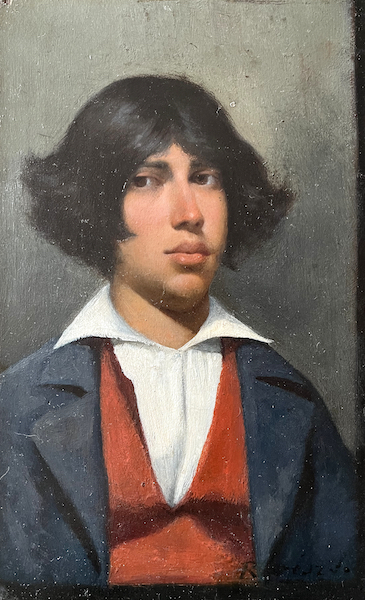Biography
He began his art studies in Vienna, and between 1873 and 1875 he became a student at the Vienna Academy of Arts, studying the methods of lithography in particular. His teachers were masters named Griepenkerl and Müller, and Viennese magazines were already writing about his works. In 1878-79, as a student at the College of Fine Arts, he was taught by Bertalan Székely, after which he returned to the Vienna Academy with a state scholarship, where he perfected his skills for three years. In 1879, at the age of 20, he won the prize of the Vienna Academy of Arts.
In the meantime, he spent his summer vacations at home and made portraits of his acquaintances and friends, such as Antal Skultéty. At the beginning of the 1880s, he had his first exhibition in Budapest, when, upon hearing about the Munkácsy competition, he submitted his painting Scene from Csárdai. The work was a great success, the jury awarded him the Mihály Munkácsy scholarship, and Queen Elizabeth bought the painting. With the help of the Munkácsy prize of six thousand francs, he traveled to Paris in 1882, where he studied and worked with the famous artist for three years. In this way, Révész got to know Munkácsy's working method, and was able to see the preparation of his study drawings and sketches. In 1884, he painted Petőfi in the Inn, which showed him as a fully mature master (it was later transferred to the London museum). The paintings and graphics of Imre Révész were chosen to illustrate the two-volume work entitled All the Poems of Sándor Petőfi, published in 1900 in Budapest by the Athenaeum.
From his travels, Révész returned several times to the regions of Kecskemét and Szentes, he made many sketches and drawings of folk life and always returned to his favorite subject, the revolution of 1848. In 1887, during his stay in Vienna, he painted the picture Runaways, which won the silver medal (or bronze medal) of the Paris exhibition in 1889.
In 1903, Révész was invited to Budapest as a lecturer at the College of Fine Arts, where he taught from 1904. In 1918, he worked at the Nagybánya artist colony. Partly in his free school, partly at the college, and partly at the artist colony in Kecskemét, which he managed between 1920 and 1931, he raised a whole generation of painters. In the 1930s, his eyesight deteriorated, and he painted little, mainly landscapes, most of which ended up in private collections.
He painted folk pictures (genre pictures), historical pictures in a naturalistic style. His main work is Panem, a characteristic work of Hungarian critical realism. His pictures Petőfi among the people, Petőfi in the camp and Csárdai scene are well-known. Later, he also painted popular, humorous portraits of life. Every single sketch and composition of Révész is evidenced by his great drawing skills and sure lines. He liked to work with mixed media, charcoal, chalk, watercolor, and pastel.

